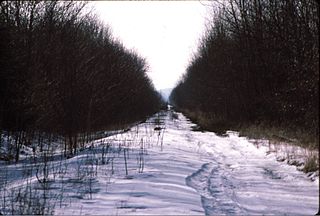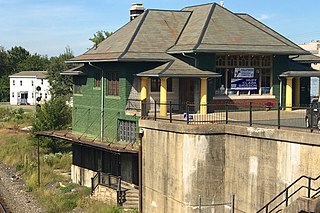
The Delaware, Lackawanna and Western Railroad, also known as the DL&W or Lackawanna Railroad, was a U.S. Class 1 railroad that connected Buffalo, New York, and Hoboken, New Jersey, and by ferry with New York City, a distance of 395 miles (636 km). The railroad was incorporated in Pennsylvania in 1853, and created primarily to provide a means of transport of anthracite coal from the Coal Region in Northeast Pennsylvania to large coal markets in New York City. The railroad gradually expanded both east and west, and eventually linked Buffalo with New York City.

For the purposes of this article, the Jersey City area extends North to Edgewater, South to Bayonne and includes Kearny Junction and Harrison but not Newark. Many routes east of Newark are listed here.

The Lehigh and Hudson River Railway (L&HR) was the smallest of the six railroads that were merged into Conrail in 1976. It was a bridge line running northeast–southwest across northwestern New Jersey, connecting the line to the Poughkeepsie Bridge at Maybrook, New York with Easton, Pennsylvania, where it interchanged with various other companies.
The Morris and Essex Railroad was a railroad across northern New Jersey, later part of the main line of the Delaware, Lackawanna and Western Railroad.

The Warren Railroad was a railroad in Warren County, New Jersey, that served as part of the Delaware, Lackawanna and Western Railroad's mainline from 1856 to 1911.

The Delaware-Lackawanna Railroad is a shortline railroad operating in Northeastern Pennsylvania, especially the Scranton area.
The Belvidere-Delaware Railroad was a railroad running along the eastern shore of the Delaware River from Trenton, New Jersey north via Phillipsburg, New Jersey to the small village of Manunka Chunk, New Jersey. It became an important feeder line for the Lehigh Valley Railroad's join to the Central Railroad of New Jersey, which was constructed into Phillipsburg, NJ at about the same time. This connected Philadelphia and Trenton, NJ at one end of the shortline railroad to the rapidly growing lower Wyoming Valley region, and via the Morris Canal or the CNJ, a slow or fast connection to New York City ferries crossing New York Harbor from Jersey City, NJ. In 1871 the CNJ leased various railroads in Pennsylvania, most from the Lehigh Coal & Navigation Company allowing the CNJ to penetrate to the upper Wyoming Valley, over some stretches, competing directly with the Lehigh Valley Railroad and with the Lehigh Canal and the trunk road connection of the Belvidere Delaware Railroad to New York became less profitable since Philadelphia connected more easily to Northeastern Pennsylvania thereafter without needing a double-crossing of the Delaware River; a general revenue decline ensued, leading to the Pennsylvania Railroad acquiring the rights, where it served as part of the Pennsylvania Railroad (PRR) system, carrying mainly anthracite coal and iron ore from northeastern Pennsylvania to population centers along the coast.

The Lackawanna Cut-Off was a rail line built by the Delaware, Lackawanna and Western Railroad (DL&W). Constructed from 1908 to 1911, the line was part of a 396-mile (637 km) main line between Hoboken, New Jersey, and Buffalo, New York. It ran west for 28.45 miles (45.79 km) from Port Morris Junction in Port Morris, New Jersey, near the south end of Lake Hopatcong about 45 miles (72 km) west-northwest of New York City, to Slateford Junction in Slateford, Pennsylvania near the Delaware Water Gap.

The High Bridge Branch is a branch line that was operated by the Central Railroad of New Jersey (CNJ). As built, the branch started in High Bridge, New Jersey at a connection with the CNJ main line and continued north to iron-ore mines in Morris County. The High Bridge Branch line followed the South Branch of the Raritan River for much of its duration.

Lake Hopatcong is a commuter railroad station for New Jersey Transit. The station, located in the community of Landing in Roxbury Township, Morris County, New Jersey, United States, serves trains for the Montclair-Boonton Line and Morristown Line at peak hours and on holiday weekends. Service from Lake Hopatcong is provided to/from Hackettstown to New York Penn Station and Hoboken Terminal. The stop is located on the tracks below Landing Road next to the eponymous Lake Hopatcong. The station consists of one active platform with shelter, and an abandoned side platform. There is no accessibility for handicapped people.

Slateford Junction was a railway junction in the small town of Slateford, Pennsylvania, that operated from 1911 to 1979.
The North Jersey Rail Commuter Association is a not for profit railroad advocacy organization that was formed and incorporated in the United States in 1980. During its history, the organization and its members have been involved in the successful advocacy of a number of projects involving NJ Transit Rail Operations. NJRCA's headquarters are located in Knowlton Township, New Jersey.

Port Morris Junction is the railroad connection between NJ Transit's Montclair-Boonton Line and the Lackawanna Cut-Off. Opened in 1911 by the Lackawanna Railroad, it is in the Port Morris, New Jersey section of Roxbury Township, New Jersey, south of Lake Hopatcong.

Roseville Tunnel is a 1,024-foot (312 m) two-track railroad tunnel on the Lackawanna Cut-Off in Byram Township, Sussex County, New Jersey. The tunnel is on a straight section of railroad between mileposts 51.6 and 51.8 (83 km), about 6 miles (9.7 km) north by northwest of Port Morris Junction. Operated for freight and passenger service from 1911 to 1979, it is undergoing work intended to return it to passenger service by 2026.

The Lackawanna Cut-Off Restoration Project is a New Jersey Transit and Amtrak effort to restore passenger service to the Lackawanna Cut-Off in northwest New Jersey.

Greendell is one of three original railway stations built by the Delaware, Lackawanna & Western Railroad (DL&W) along its Lackawanna Cut-Off line in northwestern New Jersey. The station, which still stands in Green Township at milepost 57.61 on the Cut-Off, began operations on December 23, 1911, one day before the line itself opened and the first revenue train arrived.

Andover is a planned New Jersey Transit passenger railroad station in Andover Township, in Sussex County, New Jersey, United States, providing service on its Lackawanna Cut-Off line. The line remains under construction. The station will be built at a site on Andover's Roseville Road, about 1.1 miles (1.8 km) from U.S. Route 206 and about 0.9 miles (1.4 km) from County Route 517. On the rail line, it will be located about 7.3 miles (11.7 km) west of Port Morris Junction.

The Lehigh Line is a railroad line in Central New Jersey, Northeastern Pennsylvania, and the Lehigh Valley region of eastern Pennsylvania. It is owned and operated by the Norfolk Southern Railway. The line runs west from the vicinity of the Port of New York and New Jersey in Manville, New Jersey via Conrail's Lehigh Line to the southern end of Wyoming Valley's Coal Region in Lehigh Township, Pennsylvania.

Phillipsburg Union Station is an active railroad station museum, in Phillipsburg, New Jersey, United States, at 178 South Main Street. Opened in 1914, Union Station was built by the Delaware, Lackawanna & Western Railroad (DL&W) and shared with the Central Railroad of New Jersey (CNJ) and was situated where the lines merged before the bridge crossing the Delaware River. Designed by Frank J. Nies, the architect who produced many of DL&W stations now listed state and federal registers of historic places, the 2+1⁄2 story, 3 bay brick building is unusual example of a union station and a representation of early 20th century Prairie style architecture. The Phillipsburg Union Signal Tower, or PU Tower, is nearby, also restored to its original form, and available for tours.
The Washington Secondary is a freight-only railway line in the state of New Jersey. It runs 24.3 miles (39.1 km) from Phillipsburg, New Jersey, to Hackettstown, New Jersey. It forms a connection between the Lehigh Line and Morristown Line.



















